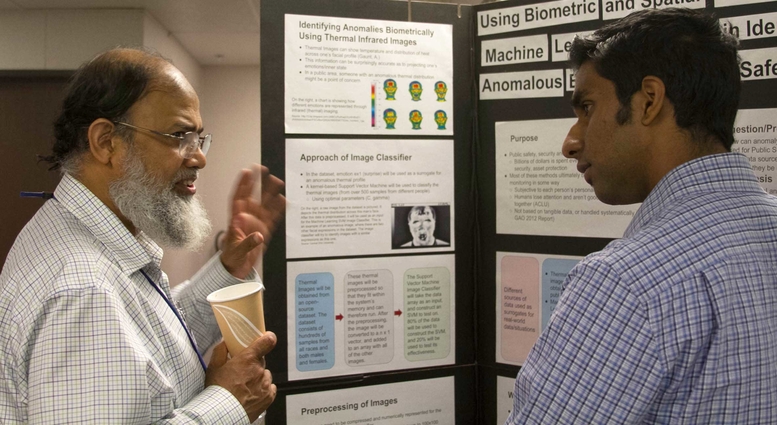CASIS workshop explores building a Wikipedia for visual queries
The 18th annual Signal and Image Sciences Workshop, a signature event of the Engineering Directorate's Center for Advanced Signal and Image Sciences (CASIS), attracted more than 100 attendees last week.
The workshop is designed to showcase R&D in signal and image sciences at Lawrence Livermore and Sandia national laboratories as well as local academic institutions and industries. It was co-sponsored by the Oakland/East Bay chapter of the Institute of Electrical and Electronics Engineers (IEEE) Signal Processing Society. The event, held at the Livermore Valley Open Campus' High Performance Computing Innovation Center, was broadcast live.
An innovative project designed to better organize, process and analyze photos on the Web was featured at the workshop along with dozens of other projects.Visipedia, a joint project between Caltech and UC San Diego, was part of a keynote presentation by Pietro Perona, an electrical engineering professor at Caltech.
Visipedia aims to make photos easily searchable and organized in the same manner by which Wikipedia organizes data from keywords or phrases. Perona and his colleagues are building a Web platform that makes photos "first-class citizens," meaning Visipedia will be able to answer visual queries as well as enable experts to contribute and organize visual knowledge.
For example, if you snapped a photo of bird but didn't know what species it was, Visipedia could help you identify it. It would ask you to upload your image, which it would then analyze and offer photos of similar bird species from its server that match your photo. You're given several possible answers, and the choice you make is the one that closely resembles your bird. The example Perona used in his presentation was an indigo bunting.
Perona said he was inspired to launch the project because it was hard for him to find information on the Internet for things he could visually observe, but couldn't identify.
"The Web is supposed to have all the information put out by man," said Perona,who is an internationally recognized expert on computational vision . "But here I am with such a simple question and I was having trouble. There was nothing inherently complicated about the question."
Visipedia's goals include the creation of hyperlinked, interactive images embedded in Wikipedia articles, scalable representations of visual knowledge, large-scale machine vision datasets and visual search capabilities. Visipedia researchers hope to achieve them by advocating the interaction and collaboration between machine vision, human users and experts.
Along with Visipedia, there were many other projects presented at CASIS in categories such as nondestructive evaluation, noninvasive imaging and inverse problems; geophysical signal processing; signal and image processing at the National Ignition Facility; optical sciences; and intelligent automation for signal and image processing.
Some projects included: The Color of Water: Using Underwater Photography to Estimate Water Quality; MicroBayesLoc: A Bayesian Approach for Locating Micro Seismic Activity; Understanding NIF Experimental Results: NIF Target Diagnostic Automated Analysis Recent Accomplishments; Imaging Space Junk with Nano-computers on Nano-satellites; Performance Simulation for Nuclear Threat Detection.
Some of the poster presentations included: Infrasound and the Search for MH370; Signal and Image Deconvolution Using Neural Networks; Incorporating Empirical Signal Detectors into Pipeline Architectures.
"It was an outstanding day for Lawrence Livermore's signal and image sciences," CASIS Co-Director Randy Roberts said. "A large percentage of workshop attendees were from other national labs, academia and industry. We were able to showcase our technologies to these groups, exchange ideas and set the stage for future collaborations."
Lab Director Bill Goldstien visited CASIS and expressed his strong support for the collaborations this kind of workshop fosters. Engineering Associate Director Monya Lane, who also attended, welcomed the crowd and expressed her strong support for signal and image sciences at the Lab.
After the workshop, the East Bay chapter of the IEEE Signal Processing Society sponsored a dinner at Zephyr Grill in Livermore with IEEE Distinguished Lecturer Bhaskar Rao, who is a professor of electrical and computer engineering at UC San Diego. Rao's presentation was titled "Bayesian Methods for Sparse Signal Recovery."
Contact
Kenneth K Ma[email protected]
925-423-7602
Related Links
CASISEngineering Directorate
Visipedia
Caltech
UC San Diego
Pietro PeronaBhaskar Rao
Tags
EngineeringIndustry Collaborations
Livermore Valley Open Campus
Featured Articles










